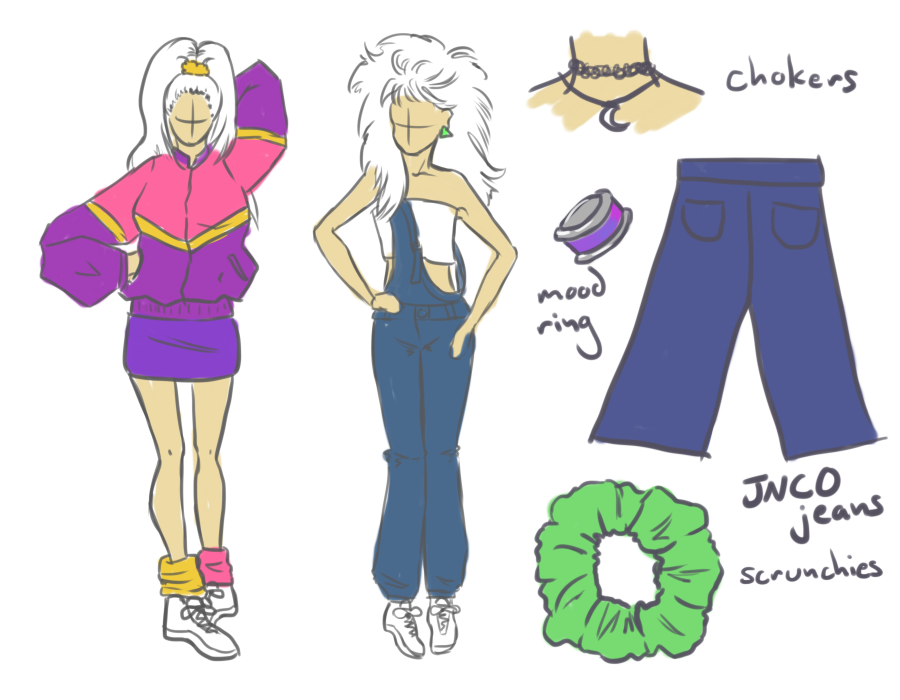The most flamboyantly awkward era of fashion has made a comeback.
Yes, fashion retailers are recycling the whimsy of our beloved ’90s — the decade we spent in a hodgepodge of bold primary colors, eccentric patterns and a plethora of plaid and grunge galore — into our primitive modern style.
Until recently, however, the fashion of the 2000s has been gaunt — consisting of single-colored basics, patterns that err on the side of caution and watered-down colors that act too easy on the retinas. These styles are seen not only at fashion retailers, but on the runway and on celebrities such as Kanye West at the Video Music Awards this year, where he wore single-colored sweats.
The drab styles of the 2000s needed a revamping. Thankfully, the recent return of ’90s style in fashion is helping to do it, as the vivaciousness of the decade has taken our modern outfits from repetitive and conservative back to bold and self-expressive.
A phenomenon found in the original purpose of ’90s fashion — to counter mainstream consumer culture and to bring out the individuality of a younger generation eager to challenge the traditional concepts and norms of their parents — has been lost in the fashion world over the past decade.
To be completely honest, though, I originally denied my involvement — which was forced upon me by my mother, who dressed me in the gawky wardrobe the ’90s touted. The marks of my childhood were jelly shoes and a particular corduroy shirt with different-colored sleeves — outfits that, had I worn anything like them a year ago, would’ve had me beheaded at the fashion guillotine.
But after spending most of my life in the fashionably lethargic 2000s, I find myself with a better appreciation of the motivations behind ’90s couture.
Before I finally threw in the towel and bought a stretchy choker and a Wu Tang Clan shirt — to be fair, Wu Tang is forever — my wardrobe was littered with lackadaisical basics that hindered my creative side. Single-colored tops with minimal embellishment, shoes that all came in neutral tones and dresses and skirts that were always cotton dominated my closet.
Unlike my modern clothing, my new “Fresh Prince”-esque flamboyant clothes allowed everything from hot pink to studded dog collars, both of which fashion has considered tacky and outdated for most of the last decade.
This style was orignally influenced by the growing grunge music scene. Grunge advocated for a divorce from the “mainstream,” and people like Kurt Cobain, Nirvana’s frontman, led the charge. Grunge flourished in the ’90s, adopting against-the-grain styles to aid in the journey of self-expression the music itself facilitated.
While the ’90s are known for the birth of grunge, it’s also the decade that gave birth to “casual chic,” where styles like high-waisted jeans, crop tops, slouchy sweaters and hoodies became popular.
This style is apparent in television shows like “Boy Meets World,” which introduced oversized button-down shirts and baggy sweaters. Although not as outwardly expressive as the punk scene’s style, the unkempt and relaxed style was a major difference from the high-maintenance styles that had been popular until the ’80s, when everything was fitted and tidy — a product of a culture that highly valued conservatism in regard to wardrobe.
What also came with this “casual chic” style was patterns and colors that were fun and playful, in contrast to
Today’s fashion, which is stripped to its minimal essentials and rarely overdone, such as the popular non-pattern leggings for women and simplistic Ralph Lauren polos for men.
To get a better idea of the purpose behind the ’90s fashion comeback, I spoke with some its participants.
Richard Zorn, a sophomore philosophy major at Pitt who enjoys wearing ’90s-styled clothing, theorized, “The ’90s revival is a direct consequence of the more modern minimalist direction mainstream fashion has taken.”
Despite the post-2010 fashion developments that seem to prefer safety and minimal fashion risk-taking, the style of the ’90s seems to be finding its way in every fashion retail store again. Abercrombie and Fitch, commonly known for its preppier merchandise, has adopted the recent ’90s revival with leather skirts, crop tops, destroyed denim boyfriend jeans and turtlenecks for fall 2015.
Unconventional clothing stores like Urban Outfitters have also started to embrace this ’90s revival, offering an endless array of specifically grunge wardrobe with plaid skirts, T-shirt dresses, clunky boots and the staple of ’90s clothing — flannel.
“I’ve loved seeing the return of offbeat patterns, the sort that look like they could’ve been ripped out of an old, ’90s Spin magazine,” said Michael Newman, a sophomore history and statistics major at Carnegie Mellon University, another participant in the ’90s fashion comeback.
Clothing has always been a medium used for self-expression where people utilize their own bodies as blank canvases that can be altered to distinguish themselves from the rest of the population. Adding ripped-up black tights or a prim-and proper plaid skirt can easily be a mode of self-expression, but the simplistic style that has dominated most of the 2000’s doesn’t allow for bold and expressive style like ’90s fashion did.
Thankfully, our newfound desire to stray from the norm is bringing us back to a better time in fashion.
“Our generation is finally learning how to express itself and embrace its quirks. Fashion is perhaps the most direct way for us to project who we are as people — our individuality,” Newman said. “That’s the fun of wearing Coogi sweaters or vintage Hawaiian shirts or mustard corduroys — you’re not restricting your personality.”
To save yourself from compromising your individuality in your outfits, embrace the trend — wear a flannel, rip your jeans, buy a Seattle Supersonics jersey. Because, when it comes down to it, we can’t deny that Will Smith’s wardrobe, while quirky and the epitome of ’90s fashion, was indeed very fresh.
Marlo Safi primarily writes about public policy and politics for The Pitt News.
Email Marlo at [email protected]



